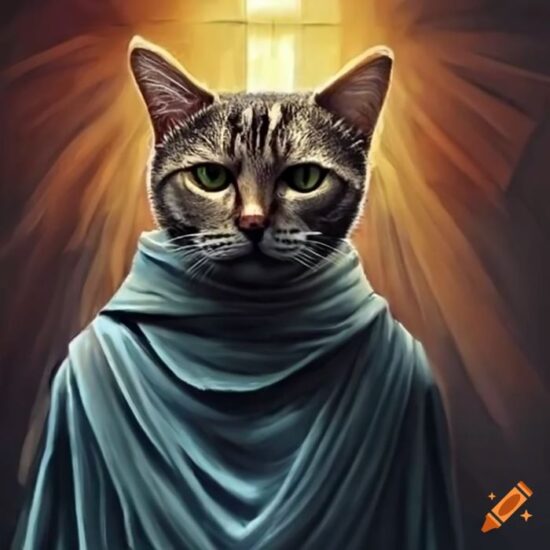Whether revered, reviled, or simply ignored, cats have in general not been served well by religious beliefs. Being regarded as sacred animals in pagan religions of the past may have placed cats among the gods, but for millions of them it also guaranteed a sacrificial death.
With the rise of Christianity it became even more dangerous for cats. Linked with devil worship, cats in Europe were nearly eradicated in the Middle Ages by the Church’s campaign of persecution.
Egyptian Goddess
The earliest historical records linking cats with religion date back thousands of years to ancient Egypt. From around 1500BCE, a cult associated with the cat-goddess Bastet (also known as Bast) began to gain ground.
Bastet, originally worshiped as a lion goddess, achieved enormous popularity in her gentler form and had a devoted following, particularly among women. In statues, she was usually represented as a cat-headed woman, sometimes surrounded by a group of small cats or kittens.
It is likely that the extreme veneration with which ancient Egyptians came to regard cats had its origins in the Bastet cult. When a family cat died, the owners went into extravagant mourning and, if they were wealthy enough, buried their mummified and decorated pet in an elaborate sarcophagus. Anyone who killed a cat, even by accident, risked being put to death.
Paradoxically, such reverence did not stop the mass slaughter of cats for religious reasons. Alongside numerous statuettes of symbolic cats, archeological excavations at ancient Egyptian sites turned up huge cat cemeteries containing mummified cats in their hundreds of thousands. X-ray examination of some of the bodies showed that the cats were young, hardly more than kittens, and had died from broken necks.
These were clearly not household pets but victims of deliberate slaughter. Various studies have come to the conclusion that the cats would have been kept by temple priests specifically for sacrificial killing and mummification, then sold to pilgrims as offerings to the gods.
 Cat worship in Egypt
Cat worship in Egypt
Sacred Icons
Outside Egypt, cats never achieved comparable religious status, although they have appeared in subsidiary roles in some belief systems. The goddess Freya in the Norse pantheon was a cat lover and drove a chariot pulled by two enormous gray cats that had been given to her as a gift by Thor, the god of thunder.
The ancient Romans were said to be great respecters of cats, the only animals allowed to enter their temples, and sometimes gave them preferential treatment as household gods, symbols of home and safety.
In the Americas, pre-Columbian civilizations knew nothing of domestic cats, which had yet to cross the Atlantic, but some of their deities were associated with big cats. Both the Mayans and the Incas worshiped gods who took the form of jaguars. In today’s major religions, cats as sacred icons remain few and far between.
One exception is the Hindu goddess Shashthi, worshiped as a protector of children, who is often depicted riding a cat. In some branches of Buddhism, the soul of someone who has attained great spirituality is said on death to enter the body of a cat. There is also an old tradition of cats, especially white ones, being kept by Buddhist monks as temple guardians.
 Freya’s cat chariot
Freya’s cat chariot
Christian Persecution
Unlike many other animals, cats are not mentioned anywhere in the Bible, either for good or evil. In a rare positive association between cats and Christianity, the 7th-century St. Gertrude, abbess of a Benedictine order near Brussels, is regarded as the patron saint of cats; she is sometimes portrayed holding a cat—or surrounded by mice.
There is some evidence that Gertrude, presumably thanks to her cats, had a reputation for keeping her abbey miraculously free of mice in an age plagued with vermin.
Another happy association is the charming legend that a cat with its litter of kittens was present in the stable at the birth of Jesus, and was marked with an “M” on its forehead—the classic coat pattern seen in tabby cats—when the Madonna stroked it.
The Christian Church’s centuries-long, well documented prejudice against cats was probably at least partly driven by a determination to stamp out the remnants of earlier pagan beliefs.
Church authorities viewed cats as agents of the Devil, especially when they were kept by people believed to be witches, and dealt with them mercilessly—maiming, torturing, hanging, and burning were among the cruelties sanctioned. Persecution of cats reached its height in the Middle Ages and continued, astonishingly, into early modern times.
 St. Gertrude of Nivelles Patron Saint of Cats
St. Gertrude of Nivelles Patron Saint of Cats
Islamic Blessing
Historically, out of all their connections with religions, cats have had the greatest acceptance in Muslim cultures, where treating animals with kindness is an important part of Islamic teaching.
The Prophet Muhammad, whose revelations in the 7th century form the text of the Holy Koran, set an example—there are many reports of the care and respect he gave to his own pets. In an Islamic version of the origins of the tabby forehead marking, the “M” is said to have been left by the Prophet’s touch.


